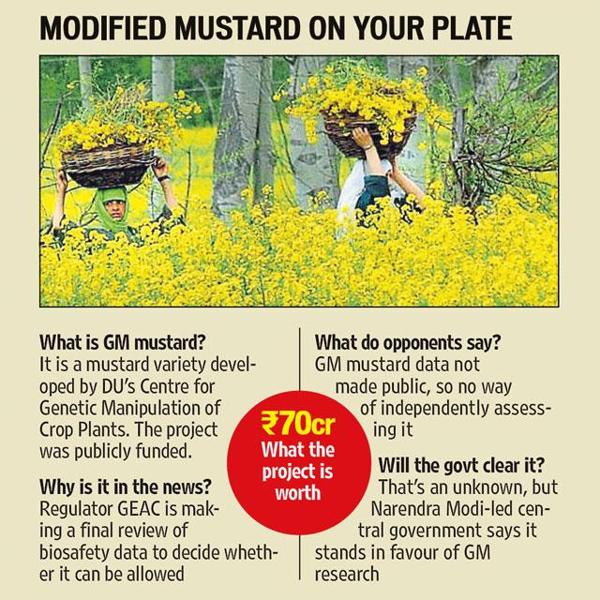What is a GM crop?
- A GM or transgenic crop is a plant that has a novel combination of genetic material obtained through the use of modern biotechnology.
- For example, a GM crop can contain a gene(s) that has been artificially inserted instead of the plant acquiring it through pollination.
- The resulting plant is said to be “genetically modified” although in reality all crops have been “genetically modified” from their original wild state by domestication, selection, and controlled breeding over long periods of time
Why GM Mustard in news?
- Recently GEAC i.e the government has deferred a decision on allowing commercial cultivation of Mustard DMH-11, a transgenic crop developed by Centre for Genetic Manipulation of Crop Plants at Delhi University.
- GM mustard (DMH11) is the first food crop to have applied for commercialisation after the indefinite ban on the GM brinjal by the Jairam Ramesh-led environment ministry in 2010.

What is GM Mustard?
- DMH-11 is a Genetically Modified (GM) mustard hybrid. Hybrids are normally obtained by crossing 2 genetically diverse plants from the same species.
- The 1st-generation offspring resulting from it has higher yields than what either of the parents is individually capable of giving. But there is no natural hybridization system in mustard, unlike in, say, cotton, maize or tomato. This is because its flowers contain both the female (pistil) and male (stamen) reproductive organs, making the plant naturally self-pollinating.
What scientist has done is to create a viable hybridization system in mustard using GM technology. The resulting GM mustard hybrid, it is claimed, gives 25-30% more yield than the best varieties such as‘Varuna’ currently grown in the country.
Scientists at the Centre for Genetic Manipulation of Crop Plants (CGMCP) in Delhi University, however, showed that this problem could be addressed by crossing Indian mustard cultivars with juncea lines of East European origin like ‘Early Heera’ and ‘Donskaja’. The combination of the 2 divergent gene pools enhanced the crossing options; the resultant F1 progeny were found to exhibit significant heterosis.
What is a controversy about GM Mustard?
- Many scientist claim that at a time when sustainable farming and low-input agriculture are becoming the buzzwords, it is surprising that agricultural scientists continue to recommend crop varieties that will end up doing more harm to the environment and crop fields. GM mustard will require almost double the quantity of fertiliser and water.
- Other health concerns of GM Hybrid Mustard include: allergenicity; gene transfer, especially of antibiotic-resistant genes, from GM foods to cells or bacteria in the gastrointestinal tract; and ‘out crossing’, or the movement of genes from GM plants to conventional crops, posing indirect threats to food safety and security.
- GM mustard can affect honeybees directly and indirectly through effecting flowering and pollen production. Protease inhibitors have proved detrimental to the longevity and behaviour of bees.
- Regulatory weakness – The Genetic Engineering Approval Committee, which is responsible for approving large-scale releases and commercialisation of GMOs, functions under the Ministry of Environment and Forests and is not entirely independent.
- The case of the Review Committee on Genetic Manipulation that supervises and clears research activities and also small-scale field trials is even starker. It is part of the Department of Biotechnology, whose primary task is to promote biotechnology. DBT therefore is the promoter as well as the regulator. On several occasions, developers of transgenic crops have also been members of regulatory committees.
Should India Ban GM Crops?
- GM technology has already been commercialized in India through Bt cotton, which is also based on incorporation of foreign genes derived from a soil bacterium, Bacillus thuringiensis.country’s cotton production has gone up more than 2½ times since Bt hybrids were first planted in 2002. Nor has any evidence emerged really of Bt cotton causing any adverse human or animal health effects.
- While the likes of Pakistan, Bangladesh, Myanmar, Philippines and Vietnam are adopting GM technology to improve crop yields and reduce input costs, we are still questioning its potential not on the basis of scientific evidence, but using emotional arguments.
- Bangladesh was the 1st country to approve the commercial planting of Bt brinjal in late-2013, after being disallowed by India. Bt brinjal has been harvested over 2 seasons, with farmers deriving better marketable yields and incomes from its successful commercialization.
Conclusion
In a current environment where climatic change would have negative effects on yield of many major crops which could seriously undermine food security, GM crops are the way forward. However at the same time to convince the opponents of GM crops to allow commercialization of GM crops we need a strong regulatory framework. What is therefore needed is an independent biotechnology regulatory authority, a single organization that will replace the multiple committees – at least six – that are part of the current regulatory structure. This authority would deal with the use of all GMOs in agriculture, pharmaceutical and biodiversity sector.
Connecting the dots:
- Write a critical note on the genetically modified crops and food production scenario in India with special focus on related policies.
- Write a brief note on genetically modified crops and how they differ from hybrid crops. What are the possible challenges and benefits of GM crops?
- Discuss the controversy regarding GM Mustard in India. Critically examine whether India should ban GM crops?
No comments:
Post a Comment